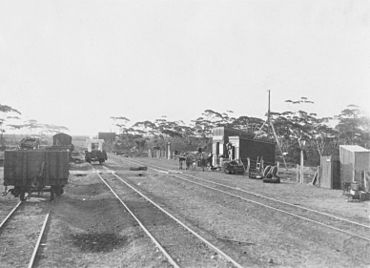Salmon Gums, Western Australia facts for kids
Quick facts for kids Salmon GumsWestern Australia |
|||||||||||||||
|---|---|---|---|---|---|---|---|---|---|---|---|---|---|---|---|

Salmon Gums railway siding in 1928
|
|||||||||||||||
| Established | 1925 | ||||||||||||||
| Postcode(s) | 6445 | ||||||||||||||
| Elevation | 249 m (817 ft) | ||||||||||||||
| Area | [convert: needs a number] | ||||||||||||||
| Location | |||||||||||||||
| LGA(s) | Shire of Esperance | ||||||||||||||
| State electorate(s) | Roe | ||||||||||||||
| Federal Division(s) | O'Connor | ||||||||||||||
|
|||||||||||||||
|
|||||||||||||||
Salmon Gums is a small town in the Goldfields-Esperance region of Western Australia. It's about 106 kilometers north of Esperance. You can find it along the Coolgardie-Esperance Highway. The town is part of the Shire of Esperance.
The name "Salmon Gums" comes from a special type of tree. These trees are called Eucalyptus salmonophloia, or Salmon Gums. They were a very important landmark when the town was first settled. The area also includes another small town called Dowak. Part of the Ngadju Indigenous Protected Area is also found here.
In 2016, a count showed that 191 people lived in Salmon Gums. The farms around the town grow wheat and other cereal crops. Salmon Gums is a place where farmers can drop off their grain. This is done through a company called Cooperative Bulk Handling.
Contents
History of Salmon Gums
Early Days and Railway Connection
The idea for a town in this spot started around 1912. It was planned as a watering stop for a new railway line. This railway would connect Esperance to Norseman. Salmon Gums was a good halfway point. The land here belonged to the indigenous Kalaako people. The town officially became a town in 1925. This happened when the railway line from Esperance reached Salmon Gums.
Soldier Settlers and Farming Challenges
After the First World War, more people moved to Salmon Gums. Soldiers returning from the war were given land grants here. These people were known as soldier settlers. At first, farming was tough in Salmon Gums. The soil wasn't very rich, and there wasn't much rain. This meant that crops didn't grow well before the 1950s. Because of these challenges, the land wasn't in high demand.
Improving Farming with Research
Things started to get better for farming before the Second World War. The Salmon Gums Research Station was set up to help. Later, in 1949, another station opened near Esperance. Scientists at this station made an important discovery. They found that the soil in the Esperance area was missing tiny amounts of important elements. These included phosphorus, copper, and zinc. Adding these elements made the soil much more fertile. This greatly improved crop yields. Since then, the region, including Salmon Gums, has become a successful farming area. Farmers now grow wheat and raise sheep and cattle.
Dowak Townsite and Nature Reserve
The townsite of Dowak was officially created in 1928. It's located right in the middle of Salmon Gums. You can find it on the Coolgardie-Esperance Highway and the railway line. West of Dowak townsite is the Dowak Nature Reserve.
Mining in the Area
In 2001, a company from Perth looked into a large deposit of lignite near Salmon Gums. Lignite is a type of soft coal. The company wanted to use it to help process iron ore. However, by 2009, all plans for mining the lignite were stopped. This was because of a big drop in the stock market. Also, lower oil prices made it too expensive to get oil from the lignite.
Climate and Weather
Salmon Gums has a mild climate that is quite dry. It's known as a semi-arid climate. The weather here is often a mix of hot, dry air from the desert and cooler, moist air from the ocean. This means temperatures can change a lot.
For example, the average highest temperature in a year can be around 43.0 degrees Celsius. The hottest temperature ever recorded was 46.3 degrees Celsius on January 28, 2011. Salmon Gums can also get very cold. The coldest temperature ever recorded was -6.1 degrees Celsius on August 15, 1970. This makes it one of the coldest places in Western Australia.
On average, Salmon Gums has about 70 days a year where the temperature reaches or goes above 30 degrees Celsius. Rain falls throughout the year, but it can be very unpredictable. Sometimes, there are very heavy rainfalls, especially in the summer.


